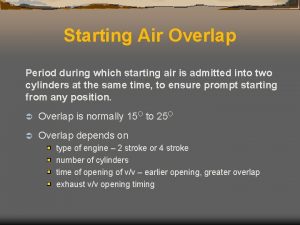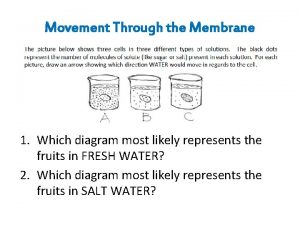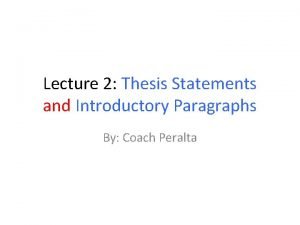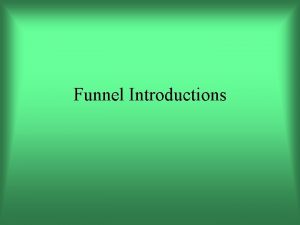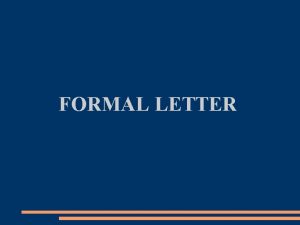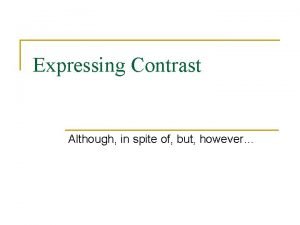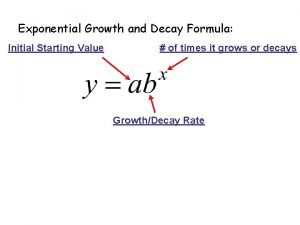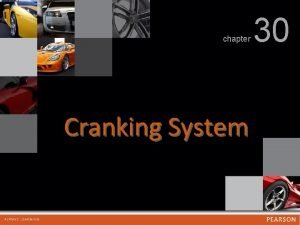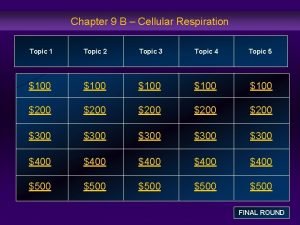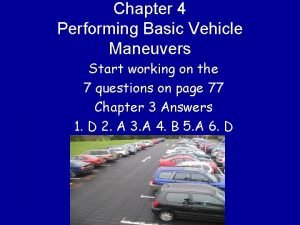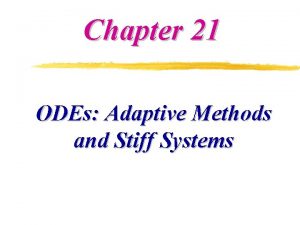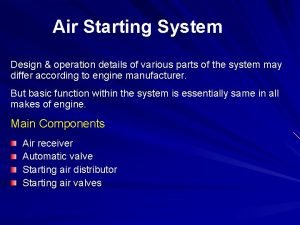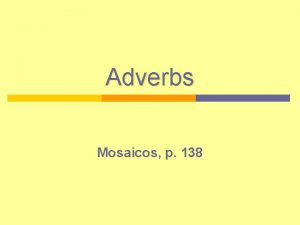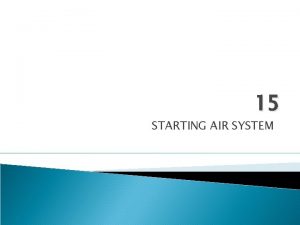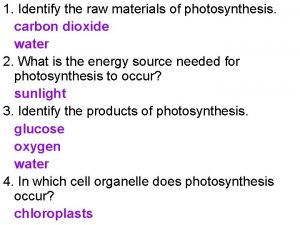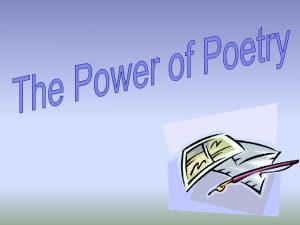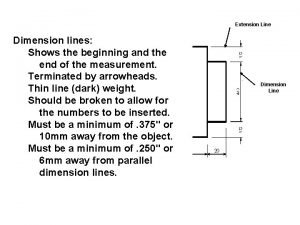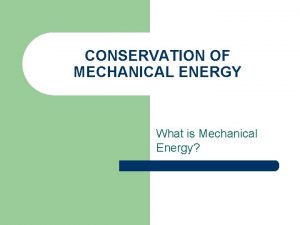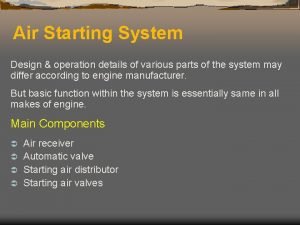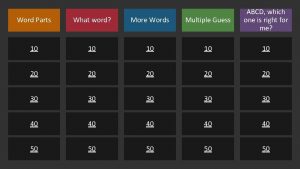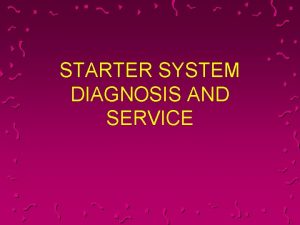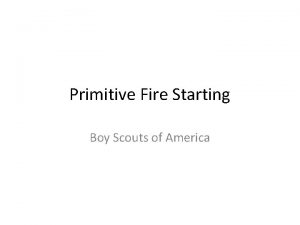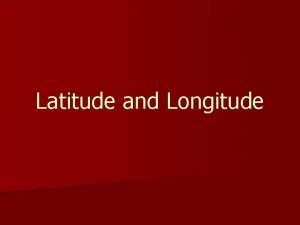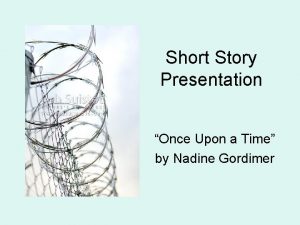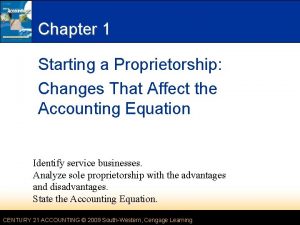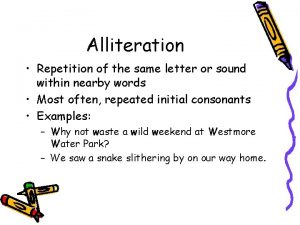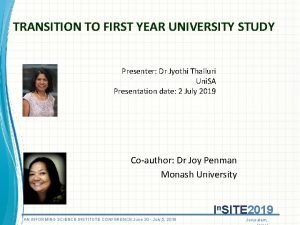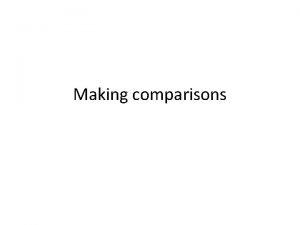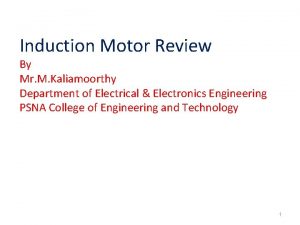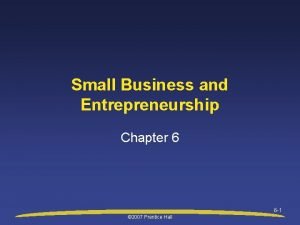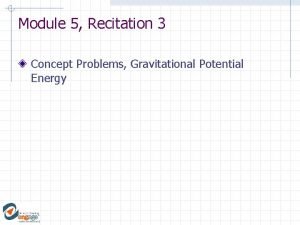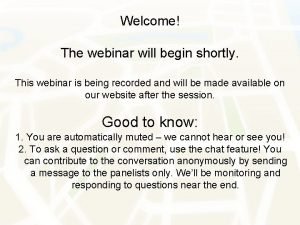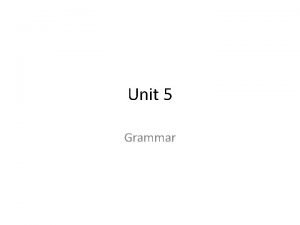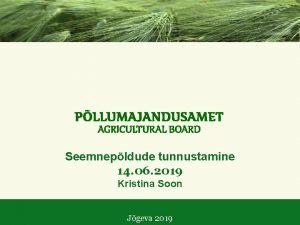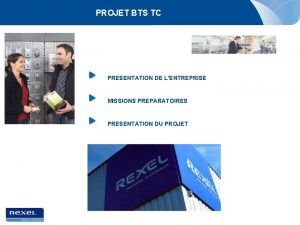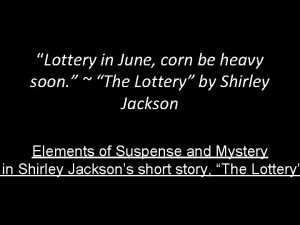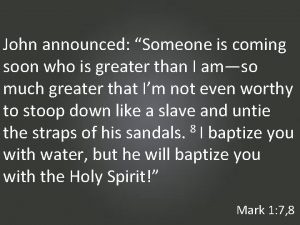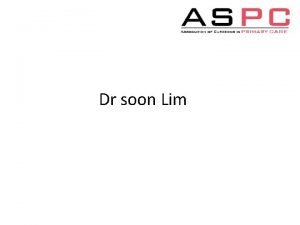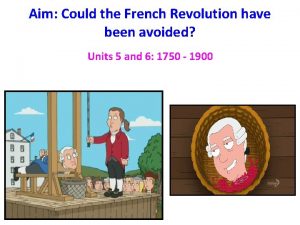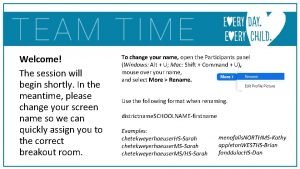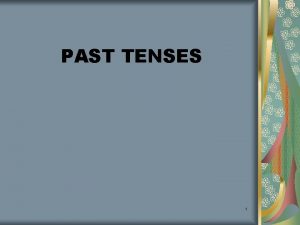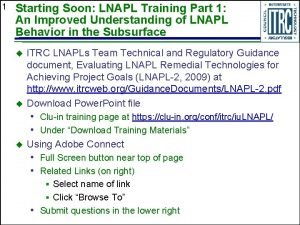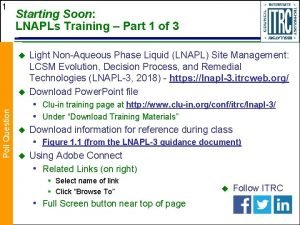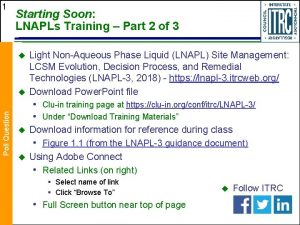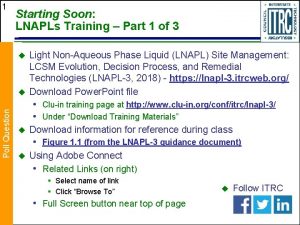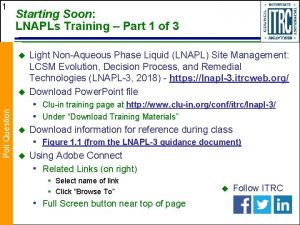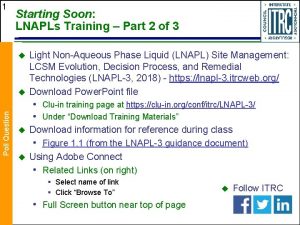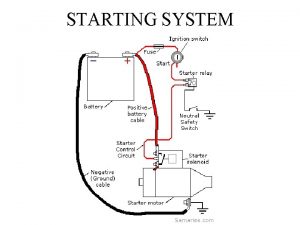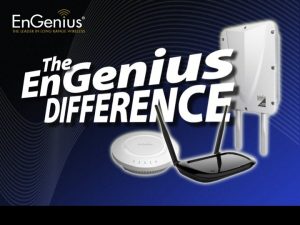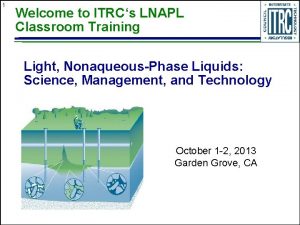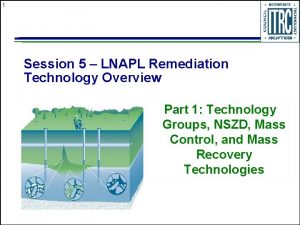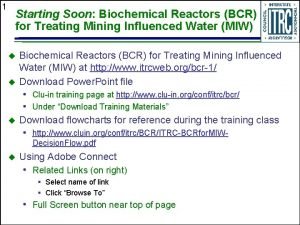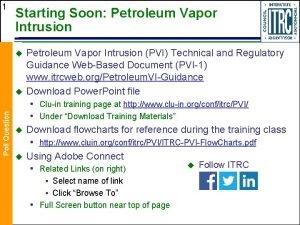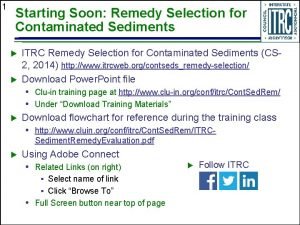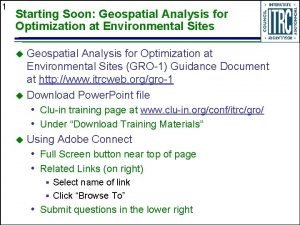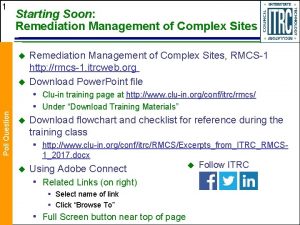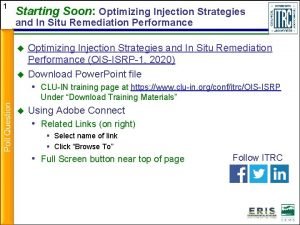1 Starting Soon LNAPL Training Part 2 LNAPL























































































- Slides: 87

1 Starting Soon: LNAPL Training Part 2: LNAPL Characterization and Recoverability – Improved Analysis u u ITRC LNAPLs Team Technical and Regulatory Guidance document, Evaluating LNAPL Remedial Technologies for Achieving Project Goals (LNAPL-2, 2009) at http: //www. itrcweb. org/Guidance. Documents/LNAPL-2. pdf Download Power. Point file • Clu-in training page at https: //clu-in. org/conf/itrc/LNAPLcr/ • Under “Download Training Materials” u Using Adobe Connect • Full Screen button near top of page • Related Links (on right) § Select name of link § Click “Browse To” • Submit questions in the lower right

2 Welcome – Thanks for joining us. ITRC’s Internet-based Training Program LNAPL Training Part 2: LNAPL Characterization and Recoverability – Improved Analysis Do you know where the LNAPL is and can you recover it? Sponsored by: Interstate Technology and Regulatory Council (www. itrcweb. org) Hosted by: US EPA Clean Up Information Network (www. cluin. org)

3 Housekeeping u u u Course time is 2¼ hours This event is being recorded Trainers control slides • Want to control your own slides? You can download presentation file on Clu-in training page u Questions and feedback • Throughout training: type in the “Q & A” box • At Q&A breaks: unmute your phone with #6 to ask out loud • At end of class: Feedback form available from last slide § Need confirmation of your participation today? Fill out the feedback form and check box for confirmation email and certificate Copyright 2017 Interstate Technology & Regulatory Council, 50 F Street, NW, Suite 350, Washington, DC 20001

4 ITRC (www. itrcweb. org) – Shaping the Future of Regulatory Acceptance u u u Host organization Network • State regulators Disclaimer • Full version in “Notes” section • Partially funded by the U. S. government § All 50 states, PR, DC § ITRC nor US government • Federal partners warranty material § ITRC nor US government DOE DOD • ITRC Industry Affiliates Program • Academia • Community stakeholders u Follow ITRC endorse specific products EPA u ITRC materials available for your use – see usage policy u Available from www. itrcweb. org • Technical and regulatory guidance documents • Online and classroom training schedule • More…

5 Meet the ITRC Trainers Pamela S. Trowbridge, P. G. Pennsylvania Department of Environmental Protection Harrisburg, PA 717 -705 -4839 ptrowbridg@pa. gov Derek Tomlinson, P. Eng. , BCEE GEI Consultants, Inc Exton, Pennslyvania 484 -872 -7018 dtomlinson@geiconsultants. com Steven Ueland, P. E. Langan Engineering & Environmental Services Doylestown, PA 215 -491 -6500 sueland@langan. com

6 LNAPL Training Part 2 Introduction and Part 1 summary u LNAPL conceptual site model u LNAPL site characterization u Q&A u Hydraulic recovery evaluation and limits u LNAPL management objectives and goals u Introduction to LNAPL remedial technologies u Q&A u

7 LNAPL Training Part 2 Introduction and Part 1 summary u LNAPL conceptual site model u LNAPL site characterization u Q&A u Hydraulic recovery evaluation and limits u LNAPL management objectives and goals u Introduction to LNAPL remedial technologies u Q&A u

8 Part 1 Summary of LNAPL Basics u u LNAPLs do not form a “pancake, ” but are distributed in multi-phase vertical equilibrium. LNAPL saturations are not uniform, controlled by soil heterogeneity. Specific volume of LNAPL in soil: For a given LNAPL thickness in a monitor well, more in coarse-grained and less in fine-grained soils. As LNAPL saturation increases, relative permeability, and LNAPL migration potential increases.

9 Part 1 Summary of LNAPL Basics (continued) u u Pressure exerted by LNAPL must exceed the displacement soil pore entry pressure for LNAPL to enter a water-filled soil pore. A measurable LNAPL thickness in a monitor well does not necessarily indicate that LNAPL is migrating. For water wet media Part 1 - Basic principles of LNAPL distribution and mobility Flow Part 2 - LNAPL characterization, Conceptual Site Model, and recovery evaluation Flow

10 Purpose of Today’s Training Event Better Understanding, Better Decisions Identify relevant LNAPL and site characterization data (what, how, why). u Demonstrate use of Part 1 concepts in evaluating LNAPL recoverability. u Discuss factors used to match remedial objectives with u LNAPL remedial technologies.

11 Simplified Subsurface LNAPL Processes Release Source Vapor Phase Vadose Zone LNAPL Capillary Fringe Dissolved Phase Modified from Huntley and Beckett, 2002

12 The Three Basic LNAPL Site Scenarios Covered in this training LNAPL sat > residual 1 LNAPL sat > residual 2 LNAPL sat < residual 3 Condition: LNAPL in wells, mobile Driver: LNAPL saturation Condition: LNAPL in wells, mobile, not migrating Driver: LNAPL composition, saturation Condition: No LNAPL in wells Driver: LNAPL composition

13 LNAPL Concerns and Drivers LNAPL Concerns: u u u Explosive hazards Dissolved-phase concentration Vapor-phase concentration Direct contact or ingestion LNAPL driver: LNAPL Composition Mobility (spreads and creates new or increased risk) Visible aesthetics LNAPL Saturation Regulatory driver: “recover to maximum extent practicable” – State’s interpretation?

14 LNAPL Understanding is an Iterative Process LNAPL Characterization u u u LNAPL composition LNAPL saturation LNAPL location LNAPL Conceptual Site Model LNAPL Management u u Maximum extent practicable? Drivers: mobility and future risk Remedial objectives and end points Remedial action selection

15 LNAPL Training Part 2 Introduction and Part 1 summary u LNAPL conceptual site model u LNAPL site characterization u Q&A u Hydraulic recovery evaluation and limits u LNAPL management objectives and goals u Introduction to LNAPL remedial technologies u Q&A u

16 LNAPL Conceptual Site Model (LCSM) u u u Site characterization and management link Description and interpretation of physical and chemical state of the LNAPL body Facilitates understanding of the LNAPL conditions, site risks, and how best to remediate Scaled to the LNAPL impacts and associated issues that require management Iterative process to increase the understanding of the LNAPL body and site risks Sufficient when additional information likely would not lead to a different decision

17 LNAPL Conceptual Site Model (LCSM) u LCSM used to understand • • Delineation (horizontal and vertical) Age and Chemical/Physical Character Volume Mobility (or Stability) Longevity Recoverability Source / Pathway / Receptors LCSM used to help make management decisions

18 LCSM (Major) Components Utility corridor/ drain Source: Garg Drinking water well LNAPL emergency issues when LNAPL in the ground LNAPL Risk when LNAPL in the ground (evaluated using RCBA) accumulation in confined Groundwater 2 1 Vapor spaces causing explosive conditions (dissolved phase) 3 a Not shown - Direct LNAPL migration 2 LNAPL to vapor to surface water 3 b 2 Groundwater to vapor Not shown - Direct LNAPL migration Not shown - Direct skin to underground spaces contact Additional LNAPL Risks when LNAPL in wells (not evaluated using RCBA) LNAPL mobility (offsite 41 migration, e. g. to surface water, under houses) in well (aesthetic, 51 LNAPL reputation, regulatory)

19 Factors Affecting LCSM Complexity Potential Risk Factors Toxicity/Pathway Magnitude/GW use Mobility & mass in place/longevity cr ea s In In c re as in g Tier 2 Sites Va In i lu n cl cre e ea a fo g ne of r nu sin LC cl ed ea & ps g SM nu /o un cos p rd fe ce t & riv as rta c er ib in ha s ilit ty ll y in en co ge st of & Tier 3 Sites Hydrologic Variability Toxicity/Chemical mobility Geologic/transport complexity Business & Community Issues Low-degradability/ persistent compounds Hydrogeologic & Plume Factors Offsite Plume/Sensitive Receptors Tier 1 Sites ASTM E 2531, 2006 Example factors affecting LCSM Complexity. Note, . this is an example only, the boundary between Tiers is subjective based on user judgment

20 LNAPL Training Part 2 Introduction and Part 1 summary u LNAPL conceptual site model u LNAPL site characterization u Q&A u Hydraulic recovery evaluation and limits u LNAPL management objectives and goals u Introduction to LNAPL remedial technologies u Q&A u

21 LNAPL Site Characterization Building the LCSM Existing data u Direct methods/conventional assessment u Indirect methods u Laboratory methods u Database/empirical values u Remember: Not all of these data may be necessary

22 Example LNAPL Indicators 1. 2. 3. 4. 5. 6. 7. 8. 9. Known LNAPL release Observed LNAPL (for example, in wells or other discharges) Visible LNAPL or other direct indicator in samples Fluorescence response in LNAPL range Near effective solubility or volatility limits in dissolved or vapor phases Dissolved plume persistence and center-of mass stability TPH concentrations in soil or groundwater indicative of LNAPL presence Organic vapor analyzer (OVA) and other field observations Field screening tests positive (for example, paint filter test, dye test, shake test) Modified from: ASTM E 2531 Table 1

23 Considerations for Assessing LNAPL Presence Based on Observation u u u Estimates of the source area can be based on observations in wells, boring logs, and other visual observations • Uncorrected observations should not be used to estimate the volume or recoverability Seasonal fluctuations should be accounted into this assessment Locations of seeps along banks or other vertical cuts aid in characterizing LNAPL impacts to surface water bodies

24 Existing Soil Data Soil total petroleum hydrocarbon (TPH) data to approximate LNAPL saturation u Information from existing boring logs used to characterize LNAPL source zone geometry • Stain, odor, organic vapor meter readings u Snapl = NAPL saturation (unitless) ρb = soil bulk density (g/cm³) TPH = total petroleum hydrocarbons (mg/kg) ρn = NAPL density (g/cm³) n = porosity (Parker et al, 1994)

25 Existing Groundwater Data u Dissolved-phase plume maps • Characterize source area shape, size and depth • Assess if natural attenuation on-going • Shrinking/stable groundwater plume = shrinking/stable LNAPL body Shrinking GW = Shrinking LNAPL Stable GW = Stable/Shrinking LNAPL ? Initial time Mid-time Later time Expanding GW = Stable/Expanding LNAPL ? Groundwater Iso-Concentrations vs. Time

26 Existing LNAPL Data u LNAPL thickness data over time • • time = 0 - LNAPL saturation limits and vertical extent Characteristics of the source zone Confined or unconfined conditions Lateral stability of LNAPL body 0+ 3 months 6 months 9 months 1 year 2 year 3 year

27 Continuous Core/Field Measurements u u u Detailed soil boring logs through the zone of LNAPL are key includes • Lithology, water content, odor, soil structure, organic vapor meter readings Oilphillic dyes and ultraviolet (UV) light can aid assessment for presence of LNAPL Laboratory data used to supplement if necessary LNAPL in Yellow White Light UV Light

28 Laser Induced Fluorescence (LIF) u u Waveform Indicates General Fuel Type Different LNAPL products and different soils fluoresce differently Typically used in conjunction with Cone Penetrometer Testing (CPT) (courtesy Dakota Technologies)

29 Membrane Interface Probe (MIPs) Carrier gas supply (from MIP controller) Gas return tube (to detector) Permeable membrane Volatile organic contaminants in soil Soil conductivity measurement tip (image courtesy Geoprobe) (Photo courtesy Geoprobe)

30 Other Field Tests u u FLUTe • Useful in fractured rock and clays to identify location of LNAPL • Flexible color reactive liner that changes color in contact with NAPLs Others…

31 Laboratory Analysis u u u Common laboratory methods • Soil, groundwater and vapor concentrations • Basic soil properties (e. g. , grain size, bulk density, distribution, moisture content) Specialized laboratory analysis packages have been developed to support LNAPL evaluations for more complex LCSM Preserving core using • Fluid properties liquid nitrogen • Pore fluid saturations and soil properties • Soil capillary properties • Residual saturation • Fingerprinting Specialized soil sampling and handling procedures

32 u u Specialized Laboratory Packages for LNAPL Characterization Fluids Properties Package LNAPL and Water Pair Pore Fluid Saturation Package What When and Why • Dynamic viscosity and fluid • Used for LNAPL • Pore fluid saturations (NAPL • Used for LNAPL density at three temps, surface and interfacial tension for each fluid pair (LNAPL/water, LNAPL/air, and air/water). • ρo, μo, ρw, μw, σao, σow, σaw and water) by Dean-Stark extraction; total porosity, airfilled porosity, grain density, dry bulk density, and moisture content. • So, Sw, St, Φ recoverability evaluation • Empirical data exists and can be used as an estimate • Consider lab tests for unusual LNAPLs, LNAPL mixtures recoverability evaluation • Pre and post-treatment testing to evaluate remedy effectiveness

33 Specialized Laboratory Packages for LNAPL Characterization (continued) What u u Capillarity Package: Air/Water Drainage LNAPL Residual Saturation When and Why • Air/Water Drainage Capillary • Used for LNAPL Pressure Curve (air displacing water) with Air Permeability and Hydraulic Conductivity: includes fluid production vs. capillary pressure, total porosity, dry bulk density. • Swr, Φ, Kw, (M, α), (λ, Pd) • Centrifuge and/or water drive • Sor recoverability evaluation • Provides data needed to estimate van Genuchten, and Brooks -Corey water retention curve (calculated from data) • Used for LNAPL recoverability evaluation • Define effectiveness limits of dual and multiphase extraction

34 8 Sand size crs medium fine Silt Clay 100 6 4 50 0. 000977 Particle size, mm 0. 0313 0. 125 0 0. 500 2 6. 351 Retained Wt % Grv 0 Capillary Pressure u Define data needs based on assessment objectives LNAPL parameters may be estimated • Published “default” or “average” parameters published for soil textural class determined from lithology and grain size distribution (e. g. , API Interactive LNAPL Guide) 10 • Empirical databases useful through comparison of basic site soil properties (e. g. , API Parameter Database) Cumulative Wt % u 10 1 1 0 50 100 Water saturation, % pore volume Height above water table, ft Estimated/Empirical Values

35 Why Not Just Use Estimated Values? u Estimated values versus laboratory measurements • Consider accuracy versus cost • Is reduction in uncertainty likely to impact management decision? • Not all information is needed for every site u Typical process for characterization • Use estimated values and existing data first • Conduct sensitivity analysis • Site-specific analyses § Tiered data collection § More useful at complex sites based on geology, composition, risk, receptors

36 Summary of LCSM and LNAPL Characterization u u u LCSM helps to understand LNAPL site conditions, risks, if/why a remedy is needed and supports management decisions Site characterization methods and comprehensiveness are a function of the complexity of the LNAPL site conditions LNAPL distribution is not as simple as we thought • Not distributed as a pancake • Vertical equilibrium • LNAPL saturation is not uniform

37 Key to a Good LCSM u Risk-Based Drivers • Reduce risk-level or hazard • Exposure pathway/LNAPL specific u Non-Risk Factors (examples) • Reduce LNAPL volatilization or dissolution • Reduce source longevity • Reduce LNAPL mass or well thickness • Reduce LNAPL transmissivity • Abate LNAPL mobility • Corporate policy – liability/risk tolerance u Regulatory driver: “recover to maximum extent practicable” – State’s interpretation? Set Goals for each applicable Objective A good LCSM supports identification of appropriate Objectives and setting relevant Goals

38 LNAPL Training Part 2 Follow ITRC Introduction and Part 1 summary u LNAPL conceptual site model u LNAPL site characterization u Q&A u Hydraulic recovery evaluation and limits u LNAPL management objectives and goals u Introduction to LNAPL remedial technologies u Q&A u

39 LNAPL Training Part 2 Introduction and Part 1 summary u LNAPL conceptual site model u LNAPL site characterization u Q&A u Hydraulic recovery evaluation and limits u LNAPL management objectives and goals u Introduction to LNAPL remedial technologies u Q&A u

40 LNAPL Recovery and Site Remediation Utility corridor/ drain Source: Garg Drinking water well LNAPL emergency issues when LNAPL in the ground LNAPL Risk when LNAPL in the ground (evaluated using RCBA) accumulation in confined Groundwater 2 1 Vapor spaces causing explosive conditions (dissolved phase) 3 a Not shown - Direct LNAPL migration 2 LNAPL to vapor to surface water 3 b 2 Groundwater to vapor Not shown - Direct LNAPL migration Not shown - Direct skin to underground spaces contact Additional LNAPL Risks when LNAPL in wells (not evaluated using RCBA) LNAPL mobility (offsite 41 migration, e. g. to surface water, under houses) in well (aesthetic, 51 LNAPL reputation, regulatory)

41 Potentially Recoverable LNAPL u • Accuracy model poor when Thickness in Soil Column 0 Modeled saturation profile complex geology or varying water table • Careful assessment versus actual field conditions critical LNAPL Potentially Mobile and Recoverable u • Variable through profile • Higher in saturated zone Estimate of Residual Saturation 0 Oil Saturation (% Pore Space) Residual saturation 100 Available tools include: API LNAPL Distribution and Recovery Model (LDRM) (API 4760) and API Interactive LNAPL Guide

42 Why Do We Need to Evaluate LNAPL Recoverability for LCSM u Determine site wide recoverability distribution • Can interpolate transmissivity values to generate isopleths u Determine if LNAPL can be recovered • In meaningful quantities • Sustained Determine where LNAPL can be recovered u Assist with LNAPL recovery system management u • Seasonal fluctuation may dictate that you only recover in certain period for example u Determine when LNAPL recovery is complete

43 Methods to Estimate Potential Recoverability Weight of evidence u Field methods u • Baildown tests • Pilot test technologies u Desktop methods • Extrapolate existing system performance • Predictive models

44 Lines of Evidence to Assess Mobility LNAPL type u LNAPL release date u LNAPL release volume u Soil type u Plume stability u

45 Field Method – LNAPL Baildown Test 12 Elevation of Surface (ft) 11 Oil 10 9 Piezometric Surface 8 7 6 Water 5 4 3 2 1 0 -100 0 100 200 300 400 Elapsed Time (minutes) A Field Measurement Method For LNAPL Conductivity/Recovery Huntley, 2000

Field Method – Baildown Test Solution LNAPL Baildown Test Example; MW-6 1. K=0. 001874 ft/min Y 0=0. 43 ft Displacement (ft) 46 0. 1 0. 90. 4 180. 8 Time (min) Beckett and Lyverse, 2002

47 Field Methods – Pilot/Pumping Tests 48 Hour Product Skimming Test 250. 00 10. 0 Volume Recovered Initial Product Thickness 9. 0 8. 0 7. 0 200. 00 6. 0 150. 00 5. 0 4. 0 100. 00 3. 0 2. 0 50. 00 1. 0 0. 00 MW-1 MW-2 MW-3 MW-4 MW-5 MW-6 MW-7 MW-8 MW-9 MW-10 MW-11 MW-12 MW-13 MW-14 MW-15 Weathered Stoddard 0. 0 Weathered Gasoline Gas/Naphtha Toluene Weathered Middle Distillate Initial Product Thickness (feet) Volume Recovered (gallons) 300. 00

48 LNAPL Saturation / Transmissivity u u The zone of highest LNAPL saturation has the highest LNAPL conductivity Low LNAPL saturation results in low LNAPL conductivity Vertical equilibrium (VEQ) conditions in a sand tank LNAPL Transmissivity = Sum u u Hydraulic recovery rate is proportional to transmissivity for a given technology Well thickness does not dictate relative recoverability More information: ASTM Standard Guide for Estimation of LNAPL Transmissivity at http: //www. astm. org/Standards/E 2856. htm Saturation shark fin Residual LNAPL

49 Recovered LNAPL Thickness (ft) LNAPL Thickness and Recovery Time 1 35 day 2 k wee s ths ar n o 6 m 1 ye 30 25 20 15 10 AMR/200 -D 5 0 AMR/606 -D AMR/185 -6 1 10 (Atlantic Richfield Corporation, 2008) 100 1, 000 10, 000 Elapsed Time (Minutes) 100, 000 1, 000 Still Recovering, expected to ultimately reach ~30 ft due to confined LNAPL

50 LNAPL Transmissivities and Thicknesses (in a Well) Key Points: u LNAPL thickness is a poor indicator of LNAPL recoverability thickness is too dependent on soil type, heterogeneity, water levels, LNAPL occurrence (confined, perched, unconfined), etc. u Transmissivity (via baildown tests, pilot test, or existing recovery data) is a more direct measure of LNAPL recoverability that factors in soil type heterogeneity and water levels. (Atlantic Richfield Corporation, 2008)

51 Desktop Methods Extrapolate Existing System Performance 500000 400000 300000 200000 100000 Decline Curve Model Production Data 0 1985 1989 1993 Time (Year) 1997 Example Recovery Decline Curve Recovery rate (gallons/day) Cumulative Production (gallons) Example Cumulative Production Curve 600 500 400 300 200 100 0 0 200, 000 400, 000 Cumulative Production (gallons) (Sale, 1997; API, 2003)

LNAPL recovery rate and cumulative recovery 4, 000 120 3, 500 100 3, 000 80 Cumulative Recovery Rate 60 2, 000 1, 500 40 1, 000 20 Operating Time (days) 0 220 200 180 160 140 120 100 80 60 40 500 20 0 2, 500 Cumulative LNAPL Recovery (gallons) Desktop Methods Extrapolate Existing System Performance 0 LNAPL Recovery Rate (gallons per day) 52

Desktop Methods Extrapolate Existing System Performance LNAPL recovery decline curve analysis 60 50 40 30 Cumulative LNAPL Recovery (gallons) 4, 000 3, 500 3, 000 2, 500 2, 000 1, 500 0 1, 000 10 y = -0. 0213 x + 79. 007 R 2= 0. 8767 500 20 0 LNAPL Recovery Rate (gallons per day) 53

54 Desktop Methods Predictive Models for LNAPL Recovery u Analytical models (e. g. , API LNAPL Distribution and Recovery Model (LDRM), and API Interactive LNAPL Guide) • • u 1 -D analytical Relatively easy to use and inexpensive Good estimates (if properly applied) API LNAPL parameters database Numerical models (e. g. , ARMOS, BIOSLURP, MAGNAS 3, MARS, MOTRANS, MOVER) • 2 -D, 3 -D; consider need! • Can be headaches and expensive • May be, but not necessarily, more accurate

55 Desktop Methods Predictive Models for LNAPL Recovery u u Models typically are based on vertical equilibrium (VEQ) model and utilize in well LNAPL thicknesses If there is recovery or transmissivity measurement data, can try to “calibrate” model to match recoveries Modeling may be appropriate on more complex sites, may be useful as what-if predictor to evaluate different scenarios Additional site specific data generally required as complexity of model increases

56 LNAPL Recovery – Model Predicted and Actual (5. 2 years) Total LNAPL Recovery Volume [gallons] Modeled vs. Actual LNAPL Recovery for the Lower Refinery Recovery Well System: June 1, 2003 through Aug. 21, 2008 (62. 1 Months) 350, 000 300, 000 Total Modeled NAPL Recovery (All Six Wells – Dual Pumping) 250, 000 200, 000 Total Actual NAPL Recovery (All Six Wells - 2 yrs) 150, 000 100, 000 50, 000 0 0 1 (Atlantic Richfield Corporation, 2008) 2 3 Time [yr] 4 5 6

Updated Site Model with New 3 Layer Model (1. 75 Years of Additional Recovery) Cumulative LNAPL Recovery Volume (Gallons) 57 Cumulative LNAPL Recovery at Six Lower Refinery Recovery Wells 400, 000 Actual LNAPL Recovery vs. One. Layer and Three-Layer Model Results: 6/19/2003 to 8/21/2008 350, 000 300, 000 One-Layer (2005) Actual 250, 000 Three-Layer Model (2007) 200, 000 2 Recent Increases in Qw from 15. 1 to 21 and 32 GPM 150, 000 100, 000 50, 000 0 0 1 (Atlantic Richfield Corporation, 2008) 2 3 Time (Years) 4 5 6 updated through 5/1/2008

58 Predictive Models – Caution Warning u What is the uncertainty in the predictive models? • Vertical equilibrium? • Hydrogeologic properties • Spatial and vertical heterogeneity § Geologic § Texture/capillary properties § Fluid properties • Residual saturation • Radii of capture and influence • Ideal versus real wells Key Point: Many of these lead to overestimating volume and recovery rate, and underestimating time of recovery

59 Case Study: Recoverability Analysis Overview u Closed refinery RCRA site u 180 acres of LNAPL with potential to migrate (evaluate with modeling) Remedy decision: LNAPL recovery is required u • 250 acres underlain by hydrocarbons • Where LNAPL with the potential to migrate exists within 300 ft of downgradient boundary • Where LNAPL is a source of benzene to groundwater u u Hydraulic conductivities 240 -350 feet/day DTW 8 -12 feet Gasoline, diesel, lube oil, and composite Currently, 300, 000 gallons per year of recovery

60 Case Study: Original LNAPL Distribution With Risk to Migrate

NAPL saturation log for NM S-09 (gasoline-like NAPL) 1. 0 0. 6 Normalized ROST Correlated LNAPL saturation 0. 2 -0. 6 u u API model 0 20 40 60 80 100 LNAPL saturation (%) Calculated conductivity (cm/s) Case Study: Data and Model Comparisons Height relative to groundwater potentiometric surface (ft) 61 Comparison of tested vs. calculated NAPL conductivities 1 E-02 1 E-04 y=0. 99 x R 2=0. 48 1 E-06 1 E-04 1 E-02 Tested conductivity (cm/s) Correlate LIF, capillary data, and saturation with API spreadsheets Make saturation and conductivity predictions and validate versus field data

62 Case Study: LNAPL Transmissivity Distribution Blue = >10 -2 cm 2/sec (2. 5 acres) Teal = >10 -3 cm 2/sec (23 acres) Grey = >10 -4 cm 2/sec (82 acres) Brown = > 10 -5 cm 2/sec (179 acres)

63 Case Study: Summary of Results u LNAPL recovery will only be implemented within areas that contain benzene impacted LNAPL at an initial transmissivity greater than 10 -4 cm²/sec u Approximately 46 acres (180 acres previously)

64 LNAPL Recoverability Summary u Transmissivity • • • u u Most universal (site and condition independent) Estimated with recovery data or field testing on monitoring wells Consistent across soil types (the transmissivity accounts for it) Consistent between recovery technologies Consistent between confined, unconfined or perched conditions Transmissivity provides a consistent measure of recoverability and impacts across different LNAPL plumes within one site or across multiple sites If LNAPL transmissivity high, recoverability is high More information: ASTM Standard Guide for Estimation of LNAPL Transmissivity at http: //www. astm. org/Standards/E 2856. htm

65 LNAPL Recoverability Summary u LNAPL thickness • Inconsistent between hydraulic scenarios (unconfined, etc. ) • Inconsistent between soil types u LNAPL recovery rate (presupposes have a recovery system, and a good one) • More robust metric than LNAPL thickness • Need recovery system or pilot test data • Operational variability and technology differences make it difficult to use across technologies and/or sites • Decline curve analysis very useful for long term predictions

66 Hydraulic Recovery Limitations Pre- Hydraulic Recovery MW Post- Hydraulic Recovery MW 6 1. 8 m Ft above water-LNAPL interface 7 2. 1 1. 5 5 4 1. 2 3 0. 9 2 0. 6 0. 3 1 0. 0 0 0. 00 LNAPL 0. 10 0. 20 0. 60 0. 30 0. 20 0. 40 LNAPL Saturation Groundwater 2. 17 Residual Saturation 1. 86 1. 55 1. 24 0. 93 0. 62 0. 31 0. 0 0 0. 00 0. 10 0. 40 0. 20 0. 60 0. 30 0. 20 LNAPL Saturation

LNAPL Hydraulic Recovery: …or How Much is Left Behind 7 Relative GW Concentration Ft above water-LNAPL interface 67 6 5 4 3 2 1 0 0. 00 0. 10 0. 20 0. 30 LNAPL Saturation LNAPL Amount No Remediation 1 0. 8 0. 6 0. 4 0. 2 0 0 0. 2 0. 4 0. 6 0. 8 1 Relative Time Benzene Concentration History Post hydraulic Recovery

68 Will LNAPL Mass Recovery Abate the Concerns? Utility corridor/ drain Source: Garg Drinking water well LNAPL emergency issues when LNAPL in the ground LNAPL Risk when LNAPL in the ground (evaluated using RCBA) accumulation in confined Groundwater 2 1 Vapor spaces causing explosive conditions (dissolved phase) 3 a Not shown - Direct LNAPL migration 2 LNAPL to vapor to surface water 3 b 2 Groundwater to vapor Not shown - Direct LNAPL migration Not shown - Direct skin to underground spaces contact Additional LNAPL Risks when LNAPL in wells (not evaluated using RCBA) LNAPL mobility (offsite 41 migration, e. g. to surface water, under houses) in well (aesthetic, 51 LNAPL reputation, regulatory)

69 LNAPL Training Part 2 Introduction and Part 1 summary u LNAPL conceptual site model u LNAPL site characterization u Q&A u Hydraulic recovery evaluation and limits u LNAPL remedial objectives and goals u Introduction to LNAPL remedial technologies u Q&A u

70 Objectives, Goals and Performance Metrics Objective: A remedial objective to abate each LNAPL concern. Goal: A remediation goal for each LNAPL remedial objective. Performance Metric: A performance metric for each remediation goal. Examples Scenario 1 Scenario 2 Objective Stop LNAPL migration off site. Stop dissolved BTEX plume in (Saturation Objective) groundwater from migrating off site. (Composition Objective) Goal Remove LNAPL by skimming to reduce LNAPL head and stop LNAPL migration. Remove BTEX components in the LNAPL using air sparging & vapor extraction. Metric No LNAPL appearing in monitor wells on property line. BTEX less than MCLs in monitor wells at downgradient property line.

71 The Importance of Establishing a Long-Term Vision and Goals Start with the end in mind u Get stakeholders on the same page u Get stakeholders to agree on what is realistically achievable u Discuss remedial objectives and remediation goals u Long-term vision may be revised if goals are later found not to be achievable u EPA, March 2005, “A Decision-Making Framework for Cleanup of Sites Impacted with LNAPL” (EPA 542 -R-04 -011) u

72 LNAPL Remedial Objectives u u u Risk-based composition objectives • Reduce risk-level or hazard • Exposure pathway/LNAPL specific Non-risk saturation objectives • Reduce LNAPL flux • Reduce source longevity • Reduce LNAPL mass or well thickness • Reduce LNAPL transmissivity • Stop LNAPL migration • Corporate policy – liability/risk tolerance Regulatory driver: “recover to maximum extent practicable” • Different states have different interpretation u Different remedial strategy needed to target LNAPL composition versus LNAPL saturation objectives. u Evaluate whether remedial objectives are best addressed by changing LNAPL composition or reducing LNAPL saturation.

73 Remediation Goals Provide the Measure of Performance Remediation Goals: u Restate the remedial objective in terms of an LNAPL remedial technology u Establish endpoints at which active remediation systems can be shut down u Match remediation goals to performance metrics to measure the progress of the remedial technology u Site and project specific

74 Control-based Objectives: Do they have a place in LNAPL Management? Can LNAPL safely be left in place after the selected remedial technology has removed free product to the maximum extent practicable? May be acceptable under certain site conditions and property uses u May be acceptable if there is no effective way to remove more LNAPL and no risks remain u Can engineered or institutional controls be used? u Have LUST sites received NFA letters at sites with LNAPL left in place? u

75 Pioneering: Examples of Setting Objectives and Goals u u u ITRC: Evaluating LNAPL Remedial Technologies for Achieving Project Goals (December 2009) ITRC: Evaluating Natural Source Zone Depletion at Sites with LNAPL (April 2009) Risk-Based NAPL Management, TCEQ RG-366/ TRRP-32 (2008) Standard Guide for Development of Conceptual Site Models and Remediation Strategies for Light Nonaqueous-Phase Liquids Release to the Subsurface, ASTM E 2531 -06 (2007) A Decision-Making Framework for Cleanup of Sites Impacted with Light Non-Aqueous Phase Liquids (LNAPL), USEPA OSWER 542 -R-04 -011 (2005) ASTM – American Society for Testing and Materials OSWER – Office of Solid Waste and Emergency Response TCEQ – Texas Commission on Environmental Quality

76 LNAPL Training Part 2 Introduction and Part 1 summary u LNAPL conceptual site model u LNAPL site characterization u Q&A u Hydraulic recovery evaluation and limits u LNAPL management objectives and goals u Introduction to LNAPL remedial technologies u Q&A u

77 Choosing a Remedial Technology You now have an understanding of your site, you know what is recoverable (hydraulically) and you have goals and objectives in mind. u What physical parameters will a remedial technology manipulate? 1 u Relative Permeability • Composition • Saturation NAPL (kr. O) 0 Water Soil Pore Volume 0 100% Water Saturation NAPL Saturation 100% 0

78 LNAPL Composition u LNAPL composition is modified by increasing rates of volatilization and dissolution from the LNAPL body – phase change from liquid to vapor phase or liquid to dissolved phase. u Example technology • Vapor extraction in combination with: § Air sparging § Heating § Steam injection

79 LNAPL Saturation u u Reduce LNAPL saturation by bulk LNAPL mass removal via excavation or liquid recovery. LNAPL factors to manipulate: • LNAPL gradient – skimming, hydraulic recovery, water flood, high-vacuum extraction • LNAPL viscosity – heating, hot water flood • Interfacial tension – surfactant/co-solvent flushing • Wettability – surfactant/co-solvent flushing

80 LNAPL Saturation – Pore Entry Pressure LNAPL must displace water to enter a soil pore u Heating technologies reduce the viscosity of the LNAPL, therefore you need less pressure to move the LNAPL through the water-wet pores u Hydraulic pumping can also move For water wet media LNAPL, but some will remain trapped and won’t be removed Flow using hydraulic methods u Flow

81 LNAPL Saturation – Capillary Pressure Capillary pressure is highest at LNAPL-air interface and zero at Water-LNAPL interface u The higher the capillary pressure, the higher the LNAPL saturation u Surfactants help break the interfacial tension that is responsible for capillary rise u

82 LNAPL Saturation – Viscosity u LNAPL viscosity is important when evaluating mobility u Different petroleum products have different viscosities u Also mixtures of different products u Weathering can change LNAPL viscosity u Heating the LNAPL body reduces its viscosity and enhances LNAPL recovery

83 LNAPL Remedial Options SOURCE Removal/Treatment: remediate source Pathway Containment: eliminate pathway Natural Source Zone Depletion confirm stable / diminishing condition RECEPTOR Institutional Controls: control exposure activity KEY POINT: May include active or passive technologies, engineering or institutional controls, or a combination

84 Natural Source Zone Depletion (NSZD) u u u Loss of mass from the LNAPL body due to natural processes in the subsurface The two primary natural LNAPL mass loss processes in the subsurface are volatilization/dissolution and biodegradation This occurs whether applying a technology or not Recharge Oxygen Transport Volatilization & Biodegradation Mobile or Residual LNAPL Groundwater Flow Dissolution & Biodegradation Evaluating Natural Source Zone Depletion at Sites with LNAPL (LNAPL -1, 2009)

85 LNAPL Technical Regulatory Guidance Document ITRC LNAPL Team Tech/Reg Guidance facilitates the selection of appropriate LNAPL remedial technologies: § LNAPL site conditions § LNAPL properties § LNAPL remedial objective § LNAPL remediation goals (tech specific) § LNAPL performance metrics (tech specific) Internet-based Tech-Reg Training in 2010 KEY POINT: Remediation technology selection criteria are presented in the ITRC LNAPL Tech/Reg Guidance. 1. 2. 3. 4. 5. 6. 7. 8. 9. 10. 11. 12. 13. 14. 15. 16. 17. Excavation Physical Containment In-situ Soil Mixing Natural Source Zone Depletion (NSZD) Air Sparging/Soil Vapor Extraction (AS/SVE) LNAPL Skimming Bioslurping/Enhanced Fluid Recovery Dual Pump Liquid Extraction (DPLE) Multiphase Extraction (Dual Pump) Multiphase Extraction (Single Pump) Water Flooding In-situ Chemical Oxidation Surfactant-Enhanced Subsurface Remediation (SESR) Cosolvent Flushing Steam/Hot-Air Injection Radio Frequency Heating Three and Six-Phase Electrical Resistance Heating

86 LNAPLs Training Part 2 Summary LNAPL behavior in the subsurface is more complex than previously thought u Develop an LNAPL CSM u LNAPL characterization should be commensurate with the LNAPL site complexity and risks u LNAPL recovery addresses mobility – potential recovery is limited – LNAPL concerns are saturation or composition driven u Match LNAPL concerns with remediation objectives u

87 Follow ITRC Thank You u 2 nd question and answer break u Links to additional resources • http: //www. clu-in. org/conf/itrc/LNAPLcr/resource. cfm u Feedback form – please complete • http: //www. clu-in. org/conf/itrc/LNAPLcr/feedback. cfm Need confirmation of your participation today? Fill out the feedback form and check box for confirmation email and certificate.
 Soon and very soon my king is coming
Soon and very soon my king is coming Addition symbol
Addition symbol Part to part ratio definition
Part to part ratio definition Part part whole
Part part whole Technical object description example
Technical object description example Bar table parts
Bar table parts The phase of the moon you see depends on ______.
The phase of the moon you see depends on ______. 미니탭 gage r&r 해석
미니탭 gage r&r 해석 Thinking of starting a business
Thinking of starting a business Character traits starting with n
Character traits starting with n Qualities starting with n
Qualities starting with n Pony motor starting synchronous motor
Pony motor starting synchronous motor Starting air overlap
Starting air overlap Presentation starting speech
Presentation starting speech Fundamental starting position
Fundamental starting position Photosynthesis recipe card
Photosynthesis recipe card Tag statement
Tag statement How to begin an introduction
How to begin an introduction Rules of letter
Rules of letter Comma however
Comma however Decay or growth
Decay or growth Sturdt
Sturdt Chapter 30 engine starting systems
Chapter 30 engine starting systems Starting materials for cellular respiration
Starting materials for cellular respiration Chapter 4 performing basic maneuvers answer key
Chapter 4 performing basic maneuvers answer key Heun method
Heun method The disadvantages of franchising mainly affect
The disadvantages of franchising mainly affect Starting check number 101
Starting check number 101 Bursting disc in starting air line
Bursting disc in starting air line Formula adverb of frequency
Formula adverb of frequency Adjective with v
Adjective with v Starting air system
Starting air system Starting materials for cellular respiration
Starting materials for cellular respiration Sample of mechanical energy
Sample of mechanical energy The starting point in a presentation
The starting point in a presentation Electromagnetic spectrum lyrics
Electromagnetic spectrum lyrics Chocolate acrostic poem
Chocolate acrostic poem Creating and starting the venture
Creating and starting the venture Business plan resort
Business plan resort Greek god and goddesses family tree
Greek god and goddesses family tree Fundamental position definition
Fundamental position definition Extension line drawing
Extension line drawing Mechanical energy examples
Mechanical energy examples Hexagon agility test clockwise time average
Hexagon agility test clockwise time average The starting substances in a chemical reaction.
The starting substances in a chemical reaction. Synchronous motor hunting
Synchronous motor hunting Starting air distributor diagram
Starting air distributor diagram _____ is difficulty in starting a urinary stream.
_____ is difficulty in starting a urinary stream. Components of starting system
Components of starting system A crane lowers a girder into place
A crane lowers a girder into place Primitive fire starting
Primitive fire starting Ordering fdp
Ordering fdp Lines of latitude run from
Lines of latitude run from Aerospace engineering salary spacex
Aerospace engineering salary spacex Chapter 6 entrepreneurship and starting a small business
Chapter 6 entrepreneurship and starting a small business Chapter 6 entrepreneurship and starting a small business
Chapter 6 entrepreneurship and starting a small business Chapter 6 entrepreneurship and starting a small business
Chapter 6 entrepreneurship and starting a small business Nadine gordimer once upon a time theme
Nadine gordimer once upon a time theme Chapter 1 starting a proprietorship
Chapter 1 starting a proprietorship Repetition of words starting with the same letter
Repetition of words starting with the same letter Starting university
Starting university Sympathomimetic drugs
Sympathomimetic drugs Presentation starting words
Presentation starting words Smart in comparative form
Smart in comparative form Induction motor voltage equation
Induction motor voltage equation Reasons for starting a business gcse
Reasons for starting a business gcse Inihilation
Inihilation Khaotic comics
Khaotic comics Starting a ministry from scratch
Starting a ministry from scratch Entrepreneurship and small business management chapter 6
Entrepreneurship and small business management chapter 6 A truck initially at rest rolls down a frictionless hill
A truck initially at rest rolls down a frictionless hill Q inventions
Q inventions Please read instructions carefully before use
Please read instructions carefully before use Pony motor starting synchronous motor
Pony motor starting synchronous motor The program will begin shortly
The program will begin shortly Almost as soon as the gorilla television commercial
Almost as soon as the gorilla television commercial Please wait the webinar will begin soon
Please wait the webinar will begin soon Kristina soon
Kristina soon Swot rexel
Swot rexel What is the meaning of lottery in june, corn be heavy soon
What is the meaning of lottery in june, corn be heavy soon John announced
John announced Jesus is coming soon revelation
Jesus is coming soon revelation Dr soon lim
Dr soon lim How the french revolution could have been avoided
How the french revolution could have been avoided Meeting will start shortly
Meeting will start shortly Foreshadowing in the lottery
Foreshadowing in the lottery Past simple past continuous farkı
Past simple past continuous farkı Baal ishtar
Baal ishtar












